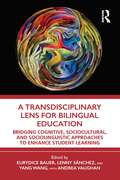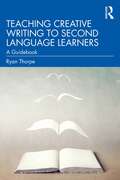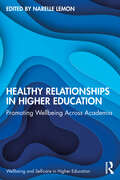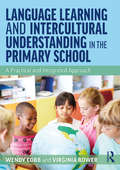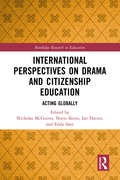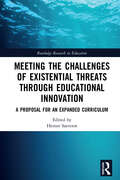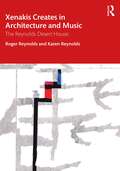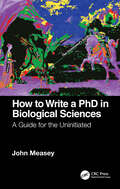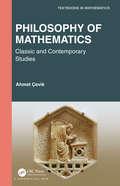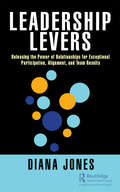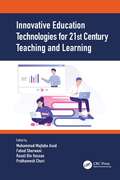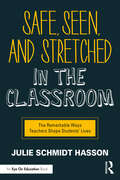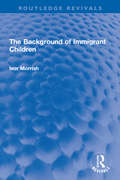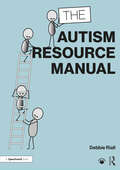- Table View
- List View
A Transdisciplinary Lens for Bilingual Education: Bridging Cognitive, Sociocultural, and Sociolinguistic Approaches to Enhance Student Learning
by Eurydice Bauer Lenny Sánchez Yang Wang Andrea VaughanAddressing the intersections between cognitive, sociocultural, and sociolinguistic research, this volume explores bilingual development across educational contexts to discuss and uncover the influences and impact of language in school programming and everyday practices. Confronting a standard monolingual lens, this collection highlights the importance of applying cross-disciplinary approaches to examine bilingualism in relation to topics such as language politics, linguistic identities, students’ experiences at home and in schools, asset-based teaching and curricula, and overall benefits. Ideal for courses in bilingualism, literacy, psychology, and language education, this text is an important resource for understanding and applying transdisciplinary, inclusive approaches to positively influence cognitive development, academic learning, and identity formation in bilingual education.
Teaching Creative Writing to Second Language Learners: A Guidebook
by Ryan ThorpeThis timely and accessible book offers engaging guidance to teachers of second language students on teaching creative writing in their classrooms. Creative writing is a tool that can inspire second language learners to write more, play with language, and enjoy and improve not only their writing, but also their speaking, listening, and reading skills. Addressing the expectations and perceptions of writing in another language, Thorpe demonstrates how to foster successful creative writing environments and teach and assess creative writing in a way that is tailored to the distinct needs of non-native speakers. Covering key topics such as cultural storytelling, voice, genre, and digital composition, assessment, and more, Thorpe shares successful creative writing instructional practices informed by current research in creative writing and second language education. Each chapter includes insights, advice, and student examples that can help new teachers take their first steps in more reflective second language creative writing classroom. An invaluable resource for instructors of non-native students and an ideal text for pre-service teachers in courses in TESOL, writing instruction, and applied linguistics, this book invites you to use creative writing not only as a successful method for teaching L2 writing, but also as a way to improve student motivation and output, for more effective language learning.
Teaching Creative Writing to Second Language Learners: A Guidebook
by Ryan ThorpeThis timely and accessible book offers engaging guidance to teachers of second language students on teaching creative writing in their classrooms. Creative writing is a tool that can inspire second language learners to write more, play with language, and enjoy and improve not only their writing, but also their speaking, listening, and reading skills. Addressing the expectations and perceptions of writing in another language, Thorpe demonstrates how to foster successful creative writing environments and teach and assess creative writing in a way that is tailored to the distinct needs of non-native speakers. Covering key topics such as cultural storytelling, voice, genre, and digital composition, assessment, and more, Thorpe shares successful creative writing instructional practices informed by current research in creative writing and second language education. Each chapter includes insights, advice, and student examples that can help new teachers take their first steps in more reflective second language creative writing classroom. An invaluable resource for instructors of non-native students and an ideal text for pre-service teachers in courses in TESOL, writing instruction, and applied linguistics, this book invites you to use creative writing not only as a successful method for teaching L2 writing, but also as a way to improve student motivation and output, for more effective language learning.
Healthy Relationships in Higher Education: Promoting Wellbeing Across Academia (Wellbeing and Self-care in Higher Education)
by Narelle LemonSelf-care involves taking action to support, protect or maintain wellbeing. Relationships have a significant influence on these acts of self-care and one’s sense of wellbeing. Relationships are fundamental to individual meaning-making and crucial to the world of academia. In this edited collection, authors navigate how they view relationships as a crucial part of their wellbeing and acts of self-care, exploring the "I", "We", and "Us" at the centre of self-care and wellbeing embodiment. Each chapter unpacks this idea in varying ways that demonstrate that relationships are a fundamental element of both work and personal life and how they intersect with wellbeing. The authors present critical discussion through visual narratives, lived experiences, and strategies that highlight how relationships, seeking social support, scaffolding opportunities to learn with and from each other, and changes in practise become acts of self-care individually and collectively. There has arguably never been a more important time to raise awareness of self-care and wellbeing as central to the nature of work in higher education. Healthy Relationships in Higher Education: Promoting Wellbeing Across Academia highlights new ways of working in higher education that disrupt current tensions that neglect wellbeing and will be of interest to anyone working in this environment.
Healthy Relationships in Higher Education: Promoting Wellbeing Across Academia (Wellbeing and Self-care in Higher Education)
by Narelle LemonSelf-care involves taking action to support, protect or maintain wellbeing. Relationships have a significant influence on these acts of self-care and one’s sense of wellbeing. Relationships are fundamental to individual meaning-making and crucial to the world of academia. In this edited collection, authors navigate how they view relationships as a crucial part of their wellbeing and acts of self-care, exploring the "I", "We", and "Us" at the centre of self-care and wellbeing embodiment. Each chapter unpacks this idea in varying ways that demonstrate that relationships are a fundamental element of both work and personal life and how they intersect with wellbeing. The authors present critical discussion through visual narratives, lived experiences, and strategies that highlight how relationships, seeking social support, scaffolding opportunities to learn with and from each other, and changes in practise become acts of self-care individually and collectively. There has arguably never been a more important time to raise awareness of self-care and wellbeing as central to the nature of work in higher education. Healthy Relationships in Higher Education: Promoting Wellbeing Across Academia highlights new ways of working in higher education that disrupt current tensions that neglect wellbeing and will be of interest to anyone working in this environment.
Language Learning and Intercultural Understanding in the Primary School: A Practical and Integrated Approach
by Wendy Cobb Virginia BowerLanguage Learning and Intercultural Understanding in the Primary School shows how to deliver a progressive and holistic embedded language curriculum. It provides guidance on inclusive approaches for students with English as an additional language, including native speakers in the target language as well as language awareness activities that maximise links with learning in English. Practical and accessible, it contains classroom examples, plans, resources and pedagogical approaches all underpinned by theory, research and practice. Each chapter examines specific themes relating to language, culture, identity and wellbeing, providing rich discussions and a range of perspectives. Case studies ‘bring to life’ the examples provided, and reflection points offer the reader the opportunity to pause and consider an idea, resource, or challenging concept before moving on. Presenting a lived narrative of shared voices, the authors invite readers to learn about their own cultural and linguistic identities and how these relate to their practice. This is a must-read for teachers, language specialists and school leaders who wish for a clear rationale for the role of language, culture, identity and wellbeing within and beyond the curriculum.
Language Learning and Intercultural Understanding in the Primary School: A Practical and Integrated Approach
by Wendy Cobb Virginia BowerLanguage Learning and Intercultural Understanding in the Primary School shows how to deliver a progressive and holistic embedded language curriculum. It provides guidance on inclusive approaches for students with English as an additional language, including native speakers in the target language as well as language awareness activities that maximise links with learning in English. Practical and accessible, it contains classroom examples, plans, resources and pedagogical approaches all underpinned by theory, research and practice. Each chapter examines specific themes relating to language, culture, identity and wellbeing, providing rich discussions and a range of perspectives. Case studies ‘bring to life’ the examples provided, and reflection points offer the reader the opportunity to pause and consider an idea, resource, or challenging concept before moving on. Presenting a lived narrative of shared voices, the authors invite readers to learn about their own cultural and linguistic identities and how these relate to their practice. This is a must-read for teachers, language specialists and school leaders who wish for a clear rationale for the role of language, culture, identity and wellbeing within and beyond the curriculum.
International Perspectives on Drama and Citizenship Education: Acting Globally (Routledge Research in Education)
by Nicholas McGuinn Norio Ikeno Ian Davies Edda SantThis book brings together respected international academics and practitioners from citizenship and drama to debate, share their experiences and plan a way forward for academic and professional best practice in drama and citizenship education for a democratic society. Drawing on international contributions, the chapters explore fundamental ideas about theatre and drama from a global perspective with connections made to action and identity. The main section of the book showcases authors from around the world discussing their perspectives of what is happening within particular countries and exploring a range of ideas and issues that relate to vitally important matters including community, socialism, post-colonialism, diversity, inclusion and more. The final section of the book brings together teams of authors from citizenship and drama education, who discuss the essential elements of citizenship education and encourage insight and practical collaboration from drama experts. The book is unique in presenting dynamic interaction between citizenship and drama experts and encouraging academics and professional to develop their own work in these areas. It will be of great interest to academics, researchers and students in the fields of citizenship education, drama education and all those interested in promoting social justice through education.
International Perspectives on Drama and Citizenship Education: Acting Globally (Routledge Research in Education)
by Nicholas McGuinnThis book brings together respected international academics and practitioners from citizenship and drama to debate, share their experiences and plan a way forward for academic and professional best practice in drama and citizenship education for a democratic society. Drawing on international contributions, the chapters explore fundamental ideas about theatre and drama from a global perspective with connections made to action and identity. The main section of the book showcases authors from around the world discussing their perspectives of what is happening within particular countries and exploring a range of ideas and issues that relate to vitally important matters including community, socialism, post-colonialism, diversity, inclusion and more. The final section of the book brings together teams of authors from citizenship and drama education, who discuss the essential elements of citizenship education and encourage insight and practical collaboration from drama experts. The book is unique in presenting dynamic interaction between citizenship and drama experts and encouraging academics and professional to develop their own work in these areas. It will be of great interest to academics, researchers and students in the fields of citizenship education, drama education and all those interested in promoting social justice through education.
Meeting the Challenges of Existential Threats through Educational Innovation: A Proposal for an Expanded Curriculum (Routledge Research in Education)
by Herner SaeverotMeeting the Challenges of Existential Threats through Educational Innovation is the first book of its kind to provide an educational and systematic analysis of problems and solutions regarding the most pressing threats that humankind is facing. The book makes a case for the importance of education responding to significant threats; including climate change, pandemics, decline in global biodiversity, overpopulation, egoism, ideologies, nuclear, biological and chemical warfare, inequality, artificial intelligence, and ignorance and the distortion of truth. Written by leading experts in their field based on cutting-edge research, the chapters explore these issues and offer suggestions for how education can address these problems in the future. This groundbreaking and highly topical book will be an essential reading for academics, researchers and post-graduate students in the fields of education research, environmental studies, educational politics and organizational management.
Meeting the Challenges of Existential Threats through Educational Innovation: A Proposal for an Expanded Curriculum (Routledge Research in Education)
by Herner SaeverotMeeting the Challenges of Existential Threats through Educational Innovation is the first book of its kind to provide an educational and systematic analysis of problems and solutions regarding the most pressing threats that humankind is facing. The book makes a case for the importance of education responding to significant threats; including climate change, pandemics, decline in global biodiversity, overpopulation, egoism, ideologies, nuclear, biological and chemical warfare, inequality, artificial intelligence, and ignorance and the distortion of truth. Written by leading experts in their field based on cutting-edge research, the chapters explore these issues and offer suggestions for how education can address these problems in the future. This groundbreaking and highly topical book will be an essential reading for academics, researchers and post-graduate students in the fields of education research, environmental studies, educational politics and organizational management.
Xenakis Creates in Architecture and Music: The Reynolds Desert House
by Roger Reynolds Karen ReynoldsXenakis Creates in Architecture and Music describes the collaborative interaction of internationally acclaimed composer Roger Reynolds, musician Karen Reynolds, and musically inspired composer, engineer, and architect Iannis Xenakis (1922-2001) to create a house design, The Reynolds Desert House. The process combined aesthetics and intuition with mathematical systems, showcasing how art and science are balanced—by way of music and architecture—to address the essential technical aspects of music along with the role of emotion and energy. The book analyzes three representative chamber works and presents a trove of primary sources: letters, diaries, notes, photographs, sketches, and person-to-person conversations. What emerges are patterns of direct parallels between how Xenakis characterized the process of musical creation and his design of The Reynolds Desert House. Xenakis Creates in Architecture and Music is a testament to the singularly innovative and creative mind of Iannis Xenakis. Supplementary materials—including color reproductions of black and white images in the book—can be found at: www.rogerreynolds.com/xenakisreynoldsroutledge.html
Xenakis Creates in Architecture and Music: The Reynolds Desert House
by Roger Reynolds Karen ReynoldsXenakis Creates in Architecture and Music describes the collaborative interaction of internationally acclaimed composer Roger Reynolds, musician Karen Reynolds, and musically inspired composer, engineer, and architect Iannis Xenakis (1922-2001) to create a house design, The Reynolds Desert House. The process combined aesthetics and intuition with mathematical systems, showcasing how art and science are balanced—by way of music and architecture—to address the essential technical aspects of music along with the role of emotion and energy. The book analyzes three representative chamber works and presents a trove of primary sources: letters, diaries, notes, photographs, sketches, and person-to-person conversations. What emerges are patterns of direct parallels between how Xenakis characterized the process of musical creation and his design of The Reynolds Desert House. Xenakis Creates in Architecture and Music is a testament to the singularly innovative and creative mind of Iannis Xenakis. Supplementary materials—including color reproductions of black and white images in the book—can be found at: www.rogerreynolds.com/xenakisreynoldsroutledge.html
How to Write a PhD in Biological Sciences: A Guide for the Uninitiated
by John MeaseyYou don’t have to be a genius to write a PhD. Of course, it will always involve a lot of hard work and dedication, but the process of writing is a whole lot easier if you understand the basic ground rules. This book is a guide through the dos and don’ts of writing a PhD. It will be your companion from the point when you decide to do a PhD, providing practical guidance to getting started, all the way through the nuts and bolts of the writing and editing process. It will also help you to get - and stay - in the right mental framework and establish good habits from the beginning, putting you in a commanding position later on. Examples are tailored to the biological sciences, offering a unique reference for PhD students in these disciplines. Embarking on a PhD doesn’t need to be daunting, even if it’s your first experience working within academia. Each short section focuses on writing - considered by many to be the most difficult aspect of a PhD - and delves into a practical detail of one aspect, from the title to the supplementary material. Whether you’re a student just starting your studies, an early career researcher or a supervisor struggling to cope, the book provides the insider information you need to get ahead.
How to Write a PhD in Biological Sciences: A Guide for the Uninitiated
by John MeaseyYou don’t have to be a genius to write a PhD. Of course, it will always involve a lot of hard work and dedication, but the process of writing is a whole lot easier if you understand the basic ground rules. This book is a guide through the dos and don’ts of writing a PhD. It will be your companion from the point when you decide to do a PhD, providing practical guidance to getting started, all the way through the nuts and bolts of the writing and editing process. It will also help you to get - and stay - in the right mental framework and establish good habits from the beginning, putting you in a commanding position later on. Examples are tailored to the biological sciences, offering a unique reference for PhD students in these disciplines. Embarking on a PhD doesn’t need to be daunting, even if it’s your first experience working within academia. Each short section focuses on writing - considered by many to be the most difficult aspect of a PhD - and delves into a practical detail of one aspect, from the title to the supplementary material. Whether you’re a student just starting your studies, an early career researcher or a supervisor struggling to cope, the book provides the insider information you need to get ahead.
Philosophy of Mathematics: Classic and Contemporary Studies (Textbooks in Mathematics)
by Ahmet CevikThe philosophy of mathematics is an exciting subject. Philosophy of Mathematics: Classic and Contemporary Studies explores the foundations of mathematical thought. The aim of this book is to encourage young mathematicians to think about the philosophical issues behind fundamental concepts and about different views on mathematical objects and mathematical knowledge. With this new approach, the author rekindles an interest in philosophical subjects surrounding the foundations of mathematics. He offers the mathematical motivations behind the topics under debate. He introduces various philosophical positions ranging from the classic views to more contemporary ones, including subjects which are more engaged with mathematical logic. Most books on philosophy of mathematics have little to no focus on the effects of philosophical views on mathematical practice, and no concern on giving crucial mathematical results and their philosophical relevance, consequences, reasons, etc. This book fills this gap. The book can be used as a textbook for a one-semester or even one-year course on philosophy of mathematics. "Other textbooks on the philosophy of mathematics are aimed at philosophers. This book is aimed at mathematicians. Since the author is a mathematician, it is a valuable addition to the literature." - Mark Balaguer, California State University, Los Angeles "There are not many such texts available for mathematics students. I applaud efforts to foster the dialogue between mathematics and philosophy." - Michele Friend, George Washington University and CNRS, Lille, France
Philosophy of Mathematics: Classic and Contemporary Studies (Textbooks in Mathematics)
by Ahmet CevikThe philosophy of mathematics is an exciting subject. Philosophy of Mathematics: Classic and Contemporary Studies explores the foundations of mathematical thought. The aim of this book is to encourage young mathematicians to think about the philosophical issues behind fundamental concepts and about different views on mathematical objects and mathematical knowledge. With this new approach, the author rekindles an interest in philosophical subjects surrounding the foundations of mathematics. He offers the mathematical motivations behind the topics under debate. He introduces various philosophical positions ranging from the classic views to more contemporary ones, including subjects which are more engaged with mathematical logic. Most books on philosophy of mathematics have little to no focus on the effects of philosophical views on mathematical practice, and no concern on giving crucial mathematical results and their philosophical relevance, consequences, reasons, etc. This book fills this gap. The book can be used as a textbook for a one-semester or even one-year course on philosophy of mathematics. "Other textbooks on the philosophy of mathematics are aimed at philosophers. This book is aimed at mathematicians. Since the author is a mathematician, it is a valuable addition to the literature." - Mark Balaguer, California State University, Los Angeles "There are not many such texts available for mathematics students. I applaud efforts to foster the dialogue between mathematics and philosophy." - Michele Friend, George Washington University and CNRS, Lille, France
Leadership Levers: Releasing the Power of Relationships for Exceptional Participation, Alignment, and Team Results
by Diana JonesThere’s an epidemic of leadership failure—whether something as small as a meeting, or as large as implementing enterprise wide change. Leaders know that sinking feeling when a gap emerges between themselves and the groups they most need to engage with. Leaders and business schools are looking in the wrong places for the cause. What holds most leaders back, as if their foot is always on the brake, is their failure to engage, and gain alignment. This book shows the reasons why. Leaders rarely recognise that: Shaping group behavior is describable as a process, which they can learn. Instead, they unconsciously fall into relationship patterns influenced by early family experiences. Informal relationship patterns have a dramatic effect on results, which is why birds in flight manage to alter course without bumping into each other. Leadership and collaboration are primarily a matter of principles and process, and not personality and content alone. If leaders master the process, they achieve consistent results. This book reveals the leadership levers to release the power of relationships for exceptional participation, alignment and results in organizations. It enables leaders to mine the brilliance that often lies dormant and untapped within their organizations. Readers will have the principles and tools to go beyond the agenda, truly engage with those around them, and release untapped capacities within their organizations. These qualities and skills will inspire associates and employees.
Innovative Education Technologies for 21st Century Teaching and Learning
by Muhammad Mujtaba Asad Fahad Sherwani Razali Bin Hassan Prathamesh ChuriThis book highlights all aspects of innovative 21st-century education technologies and skills which can enhance the teaching and learning process on a broader spectrum, based on best practices around the globe. It offers case studies on real problems involving higher education, it includes policies that need to be adaptable to the new environments such as the role of accreditation, online learning, MOOCs, and mobile-based learning. The book covers all aspects of the digital competencies of teachers to fulfill the required needs of 21st-century classrooms and uses a new pedagogical approach suitable for educational policies. Innovative Education Technologies for 21st Teaching and Learning is the first book that addresses the teaching and learning challenges and how those challenges can be mitigated by technology which educational institutions are facing due to the COVID-19 pandemic. This book is suitable for teachers, students, instructional and course designers, policymakers, and anyone interested in 21st-century education.
Innovative Education Technologies for 21st Century Teaching and Learning
by Muhammad Mujtaba AsadThis book highlights all aspects of innovative 21st-century education technologies and skills which can enhance the teaching and learning process on a broader spectrum, based on best practices around the globe. It offers case studies on real problems involving higher education, it includes policies that need to be adaptable to the new environments such as the role of accreditation, online learning, MOOCs, and mobile-based learning. The book covers all aspects of the digital competencies of teachers to fulfill the required needs of 21st-century classrooms and uses a new pedagogical approach suitable for educational policies. Innovative Education Technologies for 21st Teaching and Learning is the first book that addresses the teaching and learning challenges and how those challenges can be mitigated by technology which educational institutions are facing due to the COVID-19 pandemic. This book is suitable for teachers, students, instructional and course designers, policymakers, and anyone interested in 21st-century education.
Safe, Seen, and Stretched in the Classroom: The Remarkable Ways Teachers Shape Students' Lives
by Julie Schmidt HassonEveryone remembers their favorite teacher, but why? What makes some teachers so memorable? Julie Schmidt Hasson spent a year interviewing people about teachers who’ve shaped their lives, and the result is this captivating book. She shares stories that are both inspirational, highlighting the ways a teacher’s actions can make a lasting impact, and also informational, providing models to help teachers make a more consistent impact on the students they serve. Chapters cover topics such as commitment, vulnerability, power, connection, expectations, community, identity, and equity, while underscoring the importance of making students feel safe, seen, and stretched. In each chapter, the author brings you along as she conducts interviews and hears emotional stories. She also offers practical takeaways and applications for educators of all levels of experience. With this uplifting book, you will be reminded that your seemingly ordinary interactions in the classroom have extraordinary implications, and that you indeed have the power to influence students’ lives – each and every day.
Safe, Seen, and Stretched in the Classroom: The Remarkable Ways Teachers Shape Students' Lives
by Julie Schmidt HassonEveryone remembers their favorite teacher, but why? What makes some teachers so memorable? Julie Schmidt Hasson spent a year interviewing people about teachers who’ve shaped their lives, and the result is this captivating book. She shares stories that are both inspirational, highlighting the ways a teacher’s actions can make a lasting impact, and also informational, providing models to help teachers make a more consistent impact on the students they serve. Chapters cover topics such as commitment, vulnerability, power, connection, expectations, community, identity, and equity, while underscoring the importance of making students feel safe, seen, and stretched. In each chapter, the author brings you along as she conducts interviews and hears emotional stories. She also offers practical takeaways and applications for educators of all levels of experience. With this uplifting book, you will be reminded that your seemingly ordinary interactions in the classroom have extraordinary implications, and that you indeed have the power to influence students’ lives – each and every day.
The Background of Immigrant Children (Routledge Revivals)
by Ivor MorrishFirst published in 1971, The Background of Immigrant Children offers a deeper understanding of the diversity and richness of the customs, cultures, and religious convictions of the minority groups in a multiracial society. Ivor Morrish argues that in order to go beyond the mere tolerance of the other groups, it is becoming one of the important functions of the teacher to assist in the development of social awareness in his pupils and this must include a sympathetic involvement in the cultural ideas and outlook of groups from all over the world. This book is an attempt to introduce the teacher in training to three of the main coloured immigrant groups in Britain (West Indians, Indians, and Pakistanis), and to some of the problems that culture contact poses. This book will be a useful resource for scholars and researchers of education, multiculturalism, sociology, and social anthropology.
The Background of Immigrant Children (Routledge Revivals)
by Ivor MorrishFirst published in 1971, The Background of Immigrant Children offers a deeper understanding of the diversity and richness of the customs, cultures, and religious convictions of the minority groups in a multiracial society. Ivor Morrish argues that in order to go beyond the mere tolerance of the other groups, it is becoming one of the important functions of the teacher to assist in the development of social awareness in his pupils and this must include a sympathetic involvement in the cultural ideas and outlook of groups from all over the world. This book is an attempt to introduce the teacher in training to three of the main coloured immigrant groups in Britain (West Indians, Indians, and Pakistanis), and to some of the problems that culture contact poses. This book will be a useful resource for scholars and researchers of education, multiculturalism, sociology, and social anthropology.
The Autism Resource Manual: Practical Strategies for Teachers and other Education Professionals
by Debbie RiallThis highly practical resource book is full of realistic and achievable strategies to help teachers to support neurodiverse students in a range of situations that, whilst often seemingly insignificant, can quickly become substantial and disruptive challenges in the mainstream classroom. Written with the busy teacher in mind, chapters are easy to dip in and out of, with jargon-free language and simple explanations which are easy to understand and put into practice. Clear chapters explore a variety of situations and topics to help children engage in their learning and make the classroom a safe and inviting place to be for autistic students. Key features include: Practical and achievable strategies to support autistic students in the mainstream classroom Real-life scenarios to help you find concrete solutions to issues as they arise Memorable mantras and quick quotes to help embed strategies in everyday practice for both students and teachers Photocopiable and downloadable resource sheets Written by an advisory teacher for autism with a wealth of experience, this book will be an invaluable tool for both primary and secondary teachers in mainstream settings, as well as other education professionals.
